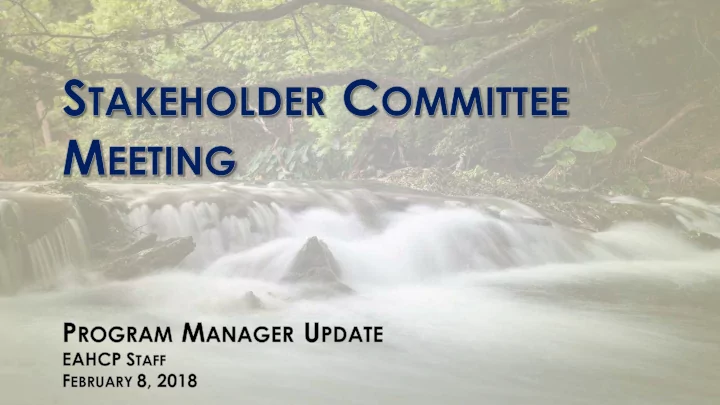

N ATIONAL A CADEMY OF S CIENCES - R EPORT 3 January 3-5 meeting: ➢ Toured Comal system restoration sites and SMARC Refugia building ➢ Statistical evaluation of long-term EAHCP Biomonitoring data ➢ Hydrological Model presentation ➢ Water Quality Protection Implementation presentation ➢ Aquifer Storage and Recovery optimization presentation Report 3 will be completed by Fall 2018
2017 A NNUAL R EPORT T IMELINE Nov 17 : Partners submitted required sections to EAHCP staff Committees review & comment on 1 st draft Jan 12 – 26 : Committees review & comment on 2 nd draft Feb 9 – 23 : Mar 16 : Final draft posted for review Mar 22 : Implementing Committee approves submittal Mar 26 : Final report submitted
2018-2019 S ESSOM C REEK P ROJECT Received 4 proposals Sessom Texas State University and TAMU AgriLife are selected contractors Creek Technical quality was the predominant ranking criteria Inflow 5/6 Science Committee members chose this group as the winning bid during the redacted review
2018-2019 S ESSOM C REEK P ROJECT Scope of Work ➢ Collect data on sediment/constituent loading ➢ Calculate sediment/constituent loading curves ➢ Data analysis and examination of the factors that contribute to sediment exports ➢ Project will support recently adopted Adaptive Management utilizing low impact development Best Management Practices in priority San Marcos watersheds to minimize sediment inputs to the river.
C OMAL S PRINGS R IFFLE B EETLE W ORK G ROUP
B ACKGROUND A CSRB distribution and abundance study was suggested by the Science Committee as part of the 2018-2019 Applied Research schedule. EAHCP staff met with TPWD staff and agreed additional monitoring through the Biomonitoring program would be the most practical approach. EAHCP staff suggested some potential locales to conduct additional sampling based on Science Committee input.
Long-term biological monitoring and proposed sampling reaches for the Comal Springs riffle beetle. Also shown are spring point features from Norris and Gibson (unpublished) 2012 mapping effort.
CSRB W ORK G ROUP After developing a draft revised sampling plan, EAHCP staff felt there were a number of areas that needed attention: ➢ How can the existing data inform changes? ▪ 1200 cotton lures have been set as part of the Biomonitoring program since 2004. ▪ Approximately 150 cotton lures were used last year as part of Refugia collections. ➢ What are the stated goals driving additional sampling? ➢ How should sampling efforts and data streams between Biomonitoring and Refugia efforts be coordinated? ➢ Are the population LTBGs appropriate? How should habitat LTBGs be quantified? ➢ What components to the biomonitoring program should be dropped to incorporate the financial burden of additional sampling? ➢ Is the cotton lure methodology appropriate? ➢ How should repeated sampling and spring identification be handled? ➢ Are we disturbing the system too much?
CSRB Work Group Fall Spring 25 25 2017 Fall Average Low-flow Average 2017 Spring Average Low-flow Average 20 20 15 15 10 10 5 5 0 0 Spring Island Spring Run 3 Western Shoreline Spring Island Spring Run 3 Western Shoreline Mean densities of adult Comal Springs riffle beetles sampled during the Spring and Fall seasons of 2017 at Spring Island, Spring Run 3, and Western Shoreline of the Comal Spring system. Long-term (2004-2017) mean densities are given to the right of the 2017 means. Error bars represent the standard deviation of the mean.
CSRB W ORK G ROUP – P ROPOSED N EXT S TEPS February 2018 Develop clear goals and committee charge with pertinent Science Committee members and Stakeholders. Identify and communicate with potential CSRB WG members Meeting 1 Discuss goals of workgroup, examine current methodology, examine existing data, and formalize data requests Meeting 2 Discuss data requests, make any additional data requests, discuss potential changes to Refugia collections/ Biomonitoring program and other workgroup goals Meeting 3 Discuss data requests, formalize changes to Refugia collection/ monitoring programs, present and finalize SOPs
Recommend
More recommend